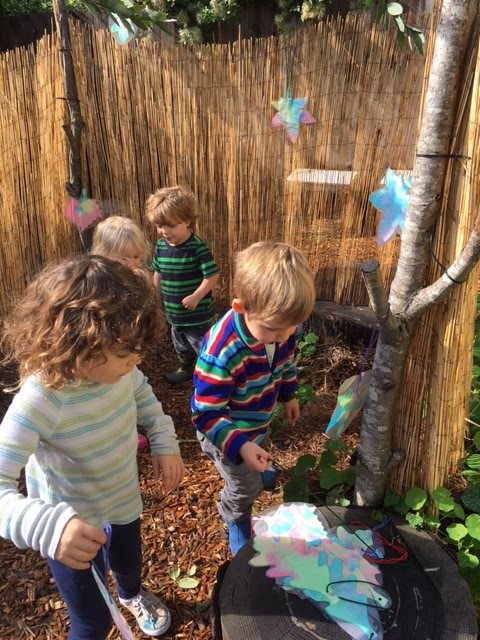The road to reading and writing is a long one in the Montessori primary classroom. It starts when a child is showing interest in sounds and can isolate beginning sounds in words. We play a game from day one called The Sound Game, in which children are presented with a row of tiny objects. I will ask a child to find an object that starts with a certain sound and the child will find it. First I start with only two objects and then we work up to more and more objects. Once a child can find an object on the first try, we move on to sandpaper letters. Sandpaper letters help children associate sounds with the shapes on the letters.
I have found, since I have such a large number of four-year-olds, that individual sandpaper letter lessons weren't enough, so I created a matching work for initial sounds. We call it "sticker work" and it is a lot of fun. I encourage children to do it together to figure out which picture matches which sound.
Two children work intently on the sticker work. Each one has 4-5 letters and 3-5 pictures per letter, with velcro dots to hold them in place.
After a child knows most of the letters by the sound it makes, we take out the movable alphabet. At least one movable alphabet is out every day in our classroom. We start with easy, mostly phonetic words, and some children are eager to build words related to their interests. Here a child wanted to build the names of machines. While working together with a child I try to help them hear each sound in a word but we spell phonetically and often vowels are left out. As a child's ability to discern each sound grows, we will work more towards including each sound and refining spelling.
Using tiny objects from the sound game is very fun, because during the sound game the children may not touch the objects. Here they can use them all to themselves.
Puzzles are an excellent tool to use with the movable alphabet as children name and label the parts of the puzzle. Here a cat puzzle has been labeled with the cat's body parts.
Concurrently with the movable alphabet, we practice writing on chalkboards, which is easier than writing with a paper and pencil because the children can quickly erase and try again.
Independent work with the movable alphabet is a sure sign of deep interest!
Moving towards reading, boxes of objects with phonetic labels are offered for matching. Again the appeal of the tiny objects and the discovery that they can read the labels is very enticing!
Three-part cards offer another opportunity to read and match words, this time with pictures. The cards are first presented with only the picture, ensuring the the child knows the vocabulary before trying to match the words.
Some children prefer to write using a pencil, and so we build the word first and then they copy it onto paper. Then they can illustrate the words they have written, a first step towards authorship!
There are many other materials used in the language area, but this is where many of our children are right now. Another aspect of Montessori language curriculum is spoken language. Teachers model correct language and clear enunciation, and use proper names for all the objects in the classroom. We play lots of verbal games using all parts of speech (simple noun games, action games, and games that use adjectives to describe different objects) that will then be revisited on a written level. Poetry, books, storytelling, conversation, and song also contribute to our love and understanding of language on a daily basis.



















































